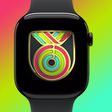In September 2021, Apple introduced the Apple Watch Series 7, featuring larger displays, improved durability, and faster charging. This came one year after Apple unveiled the Apple Watch SE, a low-cost Apple Watch option that still offers many of the Apple Watch features that have made the device so popular over the years.
The Apple Watch Series 7 starts at $399, while the Apple Watch SE is priced much more competitively at $279. As these two models share many key features, including design, water resistance, and an optical heart sensor, it may not be immediately obvious which model is better for you. Is it worth purchasing the cheaper model with fewer features? Our guide answers the question of how to decide which of these two Apple Watch models is best for you.
Comparing the Apple Watch Series 7 and the Apple Watch SE
Many of the features of these two models of Apple Watch are the same, with Apple listing the following identical features:
Similarities
- Available with aluminum casing option
- Digital Crown with haptic feedback
- Retina LTPO OLED display, with brightness of up to 1,000 nits
- "Swimproof" water resistance up to 50 meters
- 64‑bit dual-core processor
- High and low heart rate and irregular heart rhythm notifications
- Accelerometer and gyroscope (fall detection)
- Always-on altimeter
- Compass
- Ambient light sensor
- 50 percent louder speaker than Series 3
- Microphone
- Noise monitoring
- 18-hour "all-day" battery life
- GPS and GPS + Cellular models
- Support for Family Setup (GPS + Cellular models)
- International emergency calling and emergency SOS
- W3 wireless chip
- Bluetooth 5.0
- 32GB capacity
Apple's breakdown shows that these two models share a majority of features. Even so, there are a number of meaningful differences between the Apple Watch Series 7 and the Apple Watch SE that are worth highlighting, such as display size, ECGs, and blood oxygen monitoring.
Differences
- Available with aluminum casing only
- 44mm or 40mm casing sizes
- Retina display
- Display with 3.0mm borders
- S5 SiP with 64‑bit dual-core processor
- Second-generation optical heart sensor
- Available in Space Gray, Silver, and Gold
- Weighs 30.8g/36.5g
- Wi-Fi 802.11 b/g/n 2.4GHz
- Comes with 1m USB-C charging cable
- Aluminum, stainless steel, and titanium casing options
- 45mm or 41mm casing sizes
- Always-On Retina display
- 20 percent larger display with 1.7mm borders
- Crack-resistant front crystal
- IP6X dust resistance
- S7 SiP with 64‑bit dual-core processor (up to 20 percent faster than Apple Watch SE)
- Third-generation optical heart sensor
- Blood oxygen sensor
- Electrical heart sensor
- Fast charging (up to 80 percent charge in about 45 minutes)
- Aluminum models available in Midnight, Starlight, Green, Blue, and (PRODUCT)RED, stainless steel models available in Graphite, Silver, and Gold, and titanium models available in Silver and Space Black
- Aluminum models weigh 32.0g/38.8g, stainless steel 42.3g/51.5g, and titanium 37.0g/45.1g
- Wi-Fi 802.11 b/g/n 2.4GHz, 5GHz
- U1 Ultra Wideband chip
- Comes with 1m USB-C magnetic fast charging cable
Read on for a closer look at each of these aspects, and see what exactly both of the Apple Watch models have to offer.
Design
Although the Apple Watch SE and Series 7 share a similar design, the Apple Watch Series 7's case actually features a new design with softer, more rounded edges. There is only one speaker grille on the left of the device and the overall look has been slightly refined.

The display of the Apple Watch Series 7 has a refractive edge that curves around the top of the device, allowing full-screen watch faces and apps to almost reach the casing.
The casings of the Apple Watch Series 7 are also physically larger, offering 41mm and 45mm models. This is a 1mm increase over the SE's 40mm and 44mm casing sizes. All of the Apple Watch Series 7 models are also heavier than the SE models.
The Apple Watch Series 7 is available in aluminum, stainless steel, or titanium, while the Apple Watch SE is only available in aluminum. Apple Watches with stainless steel or titanium also use a sapphire crystal screen, whereas the aluminum models use Ion-X strengthened glass.
The two Apple Watch generations feature a range of different finishes and color options, and the aluminum casings have an almost completely different set of color options.
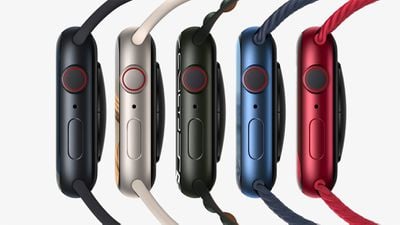
The Apple Watch SE offers Space Gray, Silver, and Gold aluminum color options, while the Apple Watch Series 7 is available in Midnight, Starlight, Green, Blue, and (PRODUCT)RED aluminum color options.
If you were particularly attached to a Space Gray, Silver, or Gold aluminum Apple Watch SE, you will have to consider what different color you would want with the Apple Watch Series 7. While it may not influence which of the two models you would buy as a first Apple Watch or upgrading from an older model, the different color options are still a noteworthy consideration.
If you prefer stainless steel or titanium, you should get the Apple Watch Series 7 as it is the only model to offer these finishes options, but if you are content with a light-weight aluminum casing, and basic Silver, Space Gray, or Gold finishes, then the Apple Watch SE will be sufficient.
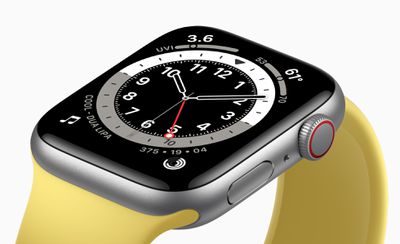
Durability
The Apple Watch Series 7 is more durable than the SE, espousing a more crack-resistant front crystal. The new crystal component has a more robust geometry and is over 50 percent thicker than that of the Apple Watch SE.
The Apple Watch Series 7 is also certified as IP6X dust-resistant, making it more durable for environments such as the beach or the desert. The Series 7, like the SE, continues to be "swimproof" with water resistance up to 50 meters deep.
While the improved durability is unlikely to singularly motivate purchases of the Series 7, it could be an important factor for users who often frequent dusty or sandy environments, or have been prone to cracking their watch in the past.
Displays
Display size is one of the most significant differences between the Apple Watch SE and Apple Watch Series 7. The SE features borders around its display that are 3.0mm thick, but the Series 7 slims these down to just 1.7mm. With the help of larger casing sizes, the Series 7 features larger displays that have almost 20 percent more screen area than on the SE.
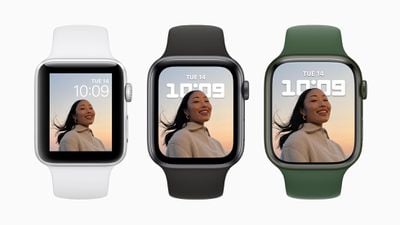 The display of the Apple Watch Series 3 (left), SE (middle), and Series 7 (right)
The display of the Apple Watch Series 3 (left), SE (middle), and Series 7 (right)The larger display of the Apple Watch Series 7 models allows them to show more content and Apple has optimized watchOS 8 to take advantage of the additional space with larger menu titles and buttons in apps. There are two additional larger font sizes and a new QWERTY keyboard that can be tapped or swiped with QuickPath.
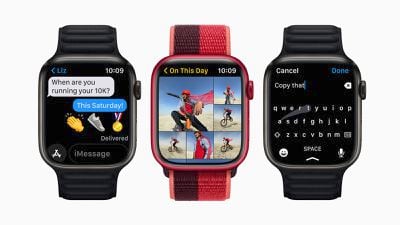
The Apple Watch Series 7 also features two exclusive watch faces, designed to showcase the larger displays and reduced borders. The new Contour face brings the animated dial right to the edge of the display and emphasizes the current hour. The new Modular Duo face leverages the additional screen space with two large center complications.
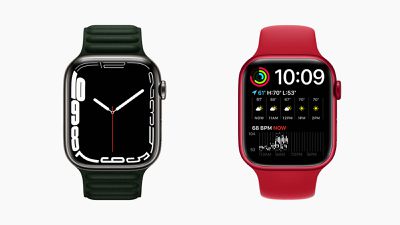 The Contour and Modular Duo exclusive watch faces
The Contour and Modular Duo exclusive watch facesBoth the Apple Watch SE and Apple Watch Series 7 come with a Retina LTPO OLED display and the maximum brightness of both displays is the same at 1,000 nits.
The Series 7 also has an always-on display. This means that even when you lower your wrist, the display remains on, so you can always see your watch face without having to raise your wrist correctly. When their wrist is down, users can also access the Notification Center and Control Center, tap on complications, and swipe to change faces without having to wake their watch screen.
The Apple Watch SE does not have an always-on display, meaning that users will have to actively raise their wrist or tap the display to see their watch face.
Unless you feel that you particularly need to see your watch face at all times without raising your wrist, the Apple Watch SE's display will be more than adequate for most user's needs. The Series 7 simply elevates the watchOS experience with more space for UI elements and the likes of a full-sized keyboard. If you have longed for a bigger Apple Watch display, the Series 7 could be a much better option than the SE, but for most users, the SE will be sufficient.
S5 vs. S7 Chip
The Apple Watch Series 7 is powered by the S7 chip, which is based around the same CPU from the S6 chip from the Apple Watch Series 6. Such is the similarity between the chips that both CPUs have the same identifier.
Apple says that the S7 chip provides a 20 percent performance improvement over the S5 chip in the Apple Watch SE, which allows apps to launch up to 20 percent faster while maintaining the same "all-day" 18-hour battery life.
The Apple Watch SE inherits the Apple Watch Series 5's S5 dual-core processor, which still "delivers incredibly fast performance," according to Apple. The S5 is up to two times faster than Apple Watch Series 3.
The S7 chip is not a major reason to choose the Apple Watch Series 7, representing a small performance improvement. The S5 was already a capable chip when it premiered in the Apple Watch Series 5, and the S7 simply offers a more refined chip.
The performance improvement of the S7 chip over the S5 does not seem to be enough to justify getting the Apple Watch Series 7 over the Apple Watch SE unless you absolutely need the fastest possible app launch speeds. For the vast majority of users, the Apple Watch SE's chip will be suitably fast and efficient.
U1 Ultra-Wideband Chip
Only the Apple Watch Series 7 contains the U1 Ultra Wideband chip. Apple says that the U1 on Apple Watch will "enable short-range wireless location to support new experiences, such as next-generation digital car keys and tracking of AirTags.
The distance between two devices that support ultra-wideband can be measured precisely by calculating the time that it takes for a radio wave to pass between the two devices, with much more accuracy than Bluetooth LE and Wi-Fi.
Since the U1 chip currently has few use cases, it is probably not worth getting the Apple Watch Series 7 simply because of it. Nevertheless, if you plan on keeping your Apple Watch for many years, the U1 chip will likely make it a much more future-proof model, due to the high chance that more functionality will come to it in the coming years.
Charging
Both Apple Watch models retain what Apple calls an "all-day" battery life of around 18 hours, but the Apple Watch Series 7 features 33 percent faster charging than the Series 6 due to a new charging architecture, which itself charged faster than the Series SE. The Apple Watch Series 6 is able to charge up to 100 percent in an hour and a half, but the Series 7 can reach 80 percent in just 45 minutes.
According to Apple, just eight minutes of charging time can provide eight hours of sleep tracking with the Series 7. This is partly thanks to a new USB-C magnetic fast charging cable that is included with the Apple Watch Series 7 in the box.
Since the battery life of both models is virtually the same, it is probably not worth favoring the Series 7 simply on the basis of faster charging and slightly improved battery usage during particular activities. The Series 7's battery and charging enhancements instead remain an important indication of how the device offers a range of small but meaningful improvements over the Apple Watch SE.
If you find that you have little time to charge your Apple Watch during the day, the Series 7's faster charging could be an important reason to upgrade for you. Even so, both devices still have the same "all-day" 18-hour battery life and will need to be recharged every day.
Health Monitoring
Apple Watch Series 7 offers blood oxygen monitoring. The feature measures the oxygen saturation of the user's blood, so they can better understand their overall fitness and wellbeing. Oxygen saturation, also known as SpO2, represents the percentage of oxygen being carried by red blood cells from the lungs to the rest of the body, and indicates how well this oxygenated blood is being delivered throughout the body.
The Apple Watch Series 6 has a blood oxygen sensor on its rear with an array of four clusters of green, red, and infrared LEDs. They measure light reflected back from blood, and using an advanced custom algorithm, can determine blood oxygen saturation between 70 and 100 percent.
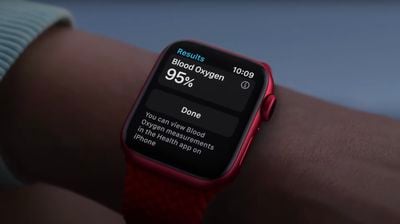
On-demand measurements can be taken using the Blood Oxygen app, and periodic background measurements are also taken, including during sleep. All data is visible in the Health app, and the user is able to track trends over time to see how their blood oxygen level changes.
Moreover, the Apple Watch Series 7 contains the electrical heart sensor from previous models that is used to take electrocardiograms, or ECGs. The Apple Watch Series 7 has electrodes built into the Digital Crown and an electrical heart rate sensor on the rear. With the ECG app, users touch the Digital Crown and after 30 seconds, receive a heart rhythm classification. It can classify if the heart is beating in a normal pattern or whether there are signs of Atrial Fibrillation (AFib), a heart condition that may lead to major health complications. All recordings, their associated classifications, and any noted symptoms are stored in the Health app in a PDF that can be shared with physicians.
The Apple Watch SE does not have a blood oxygen or electrical heart sensor to monitor either of these health statistics. However, the Apple Watch SE is not without the ability to record any health data.
The Apple Watch SE has an optical heart sensor to monitor heart rate, and can give notifications about high and low heart rate, and as well as irregular heart rhythm. The lower-cost model can also still perform emergency SOS, fall detection, and noise monitoring, just like the Apple Watch Series 7.
The additional health monitoring features of the Apple Watch Series 7 are the main appeal of the more expensive model. If you believe that ECG and blood oxygen monitoring will be important to you, you should consider the Apple Watch Series 7. If these advanced health features are less of a priority for you, the Apple Watch SE still has some insightful health monitoring capabilities.
Other Apple Watch Options
Apple also offers the Apple Watch Series 3 for $199. This older model offers substantially fewer features and has a smaller screen. The Apple Watch Series 3 is still a capable device, with 8GB of storage, water-resistance up to 50 meters, an altimeter, Emergency SOS, and an optical heart sensor. Functionally, it is more pared back than the Apple Watch SE, being thicker with larger bezels.
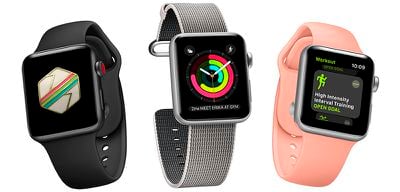
The Apple Watch Series 3 is really only intended for those who want an Apple Watch at the lowest possible price, but it will certainly be the least future-proof model. Given that the Apple Watch Series 3 is a much older model, if you can afford an Apple Watch Series 7 or Apple Watch SE, you should definitely prefer those newer options.
- Apple Watch SE vs. Apple Watch Series 3 Buyer's Guide
- Apple Watch Series 6 vs. Apple Watch SE Buyer's Guide
Final Thoughts
The Apple Watch Series 7 is an improvement over the previous Series 6 model, offering a larger display, improved durability, and faster charging. With its larger casing, always-on display, advanced health monitoring features, and range of colors and finishes, the Apple Watch Series 7 will be the model of choice for those that want the most out of their wearable. If you are particularly interested in health tracking, the larger display, fast charging, or simply like a particular casing and color combination, the Apple Watch Series 7 will be the best model for you.
Although the Apple Watch SE is now over a year old, if you are on a budget and are not particularly attracted to the additional features of the Series 7, it is still a compelling option. The Apple Watch SE will be the go-to model for many Apple Watch customers due to its competitive pricing and generous feature set, and it may be the best choice for those new to Apple Watch or users who are coming from a Series 3 or older. As it shares so many features with the Apple Watch Series 7, in most cases you should probably choose the more inexpensive model, unless you particularly value features such as the always-on display or advanced health monitoring and can justify the added cost.











